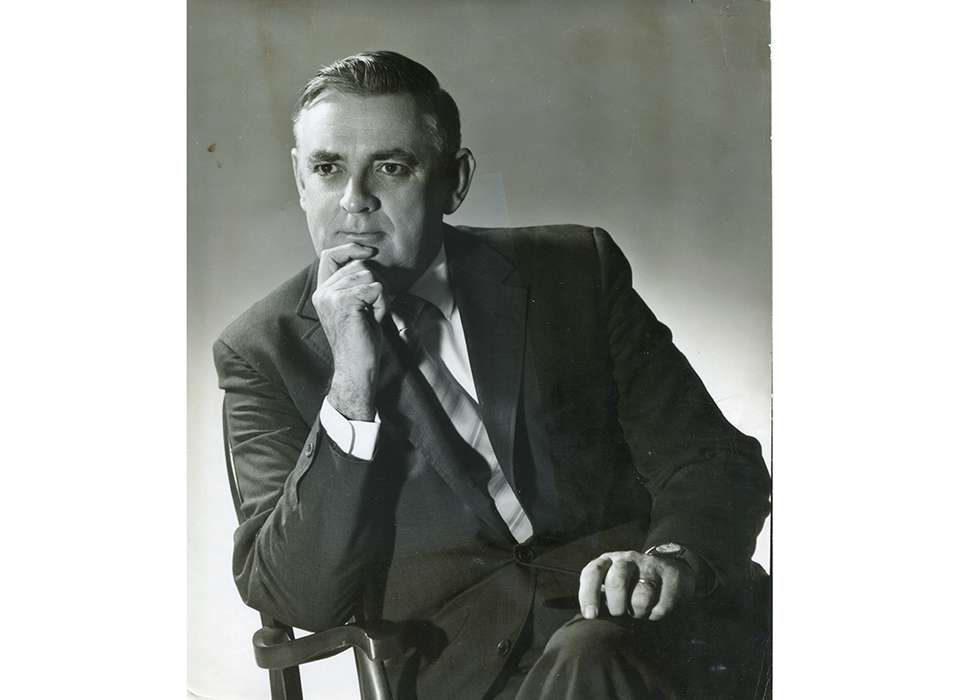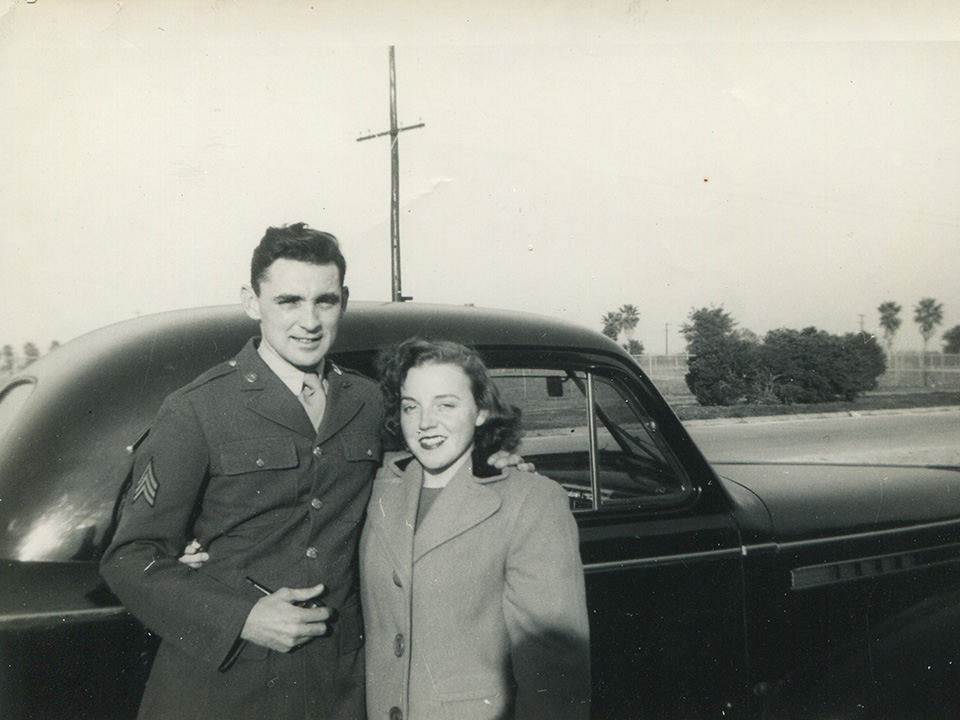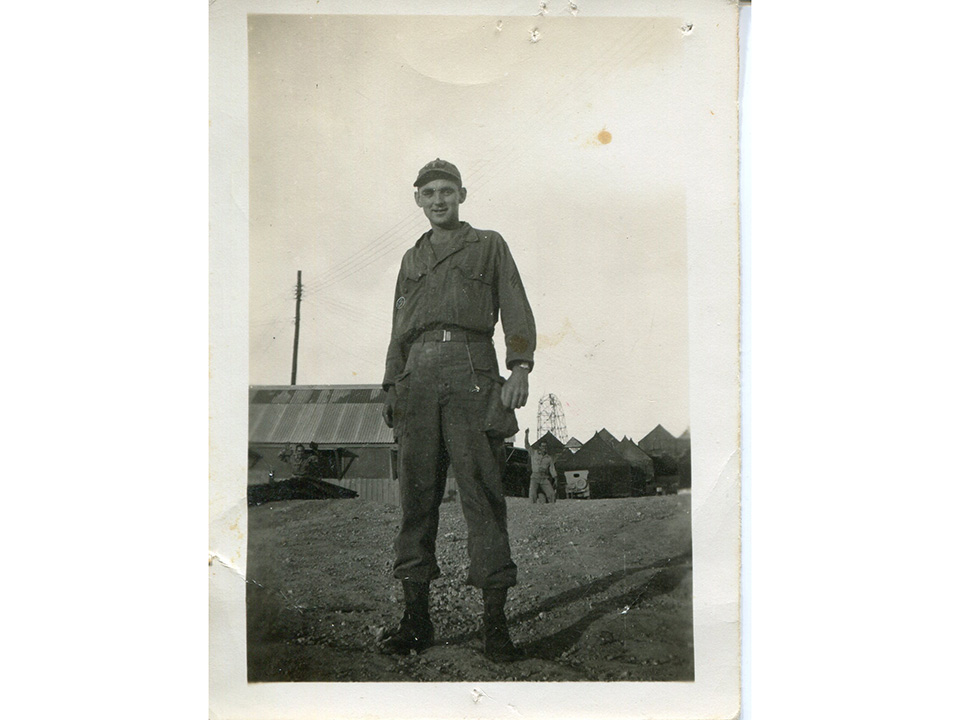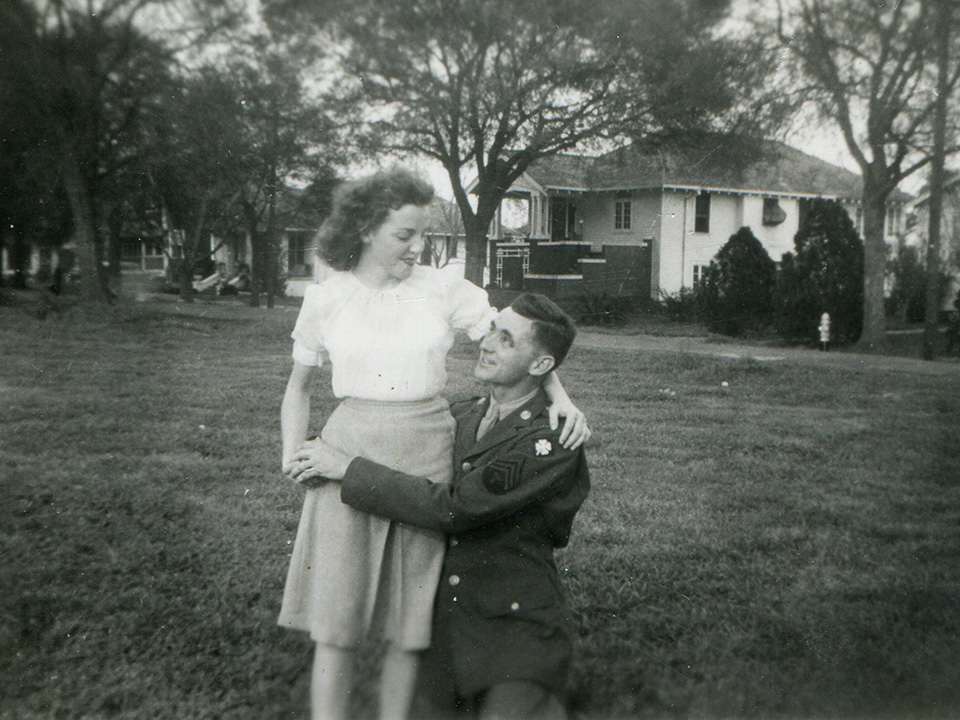My grandfathers were giants, at least in my eyes. They were my heroes not just because they were my grandfathers, but because I had known from a very early age that they had both served during World War II. Unfortunately, they both passed away when I was very young and never had a chance to talk to them, let alone preserve their experiences as I do now with other veterans for The National WWII Museum’s Oral History Program. Wanting to know what they experienced during the war is what inspired me to pursue a career in WWII history.
I had been working for The National WWII Museum for three or four years when one of my aunts sent me the article presented here today (thanks Aunt Camille!). The article, “Sir, Easy Company is all Present,” was written by my maternal grandfather, Maurice P. “Pete” Bowler, around 1972 and was inspired by a trip he had taken a couple years prior. One day, he was driving one of his daughters back to school in northern Louisiana and after dropping her off in Alexandria, he decided to pay a visit to Camp Claiborne, the base at which he had taken his basic infantry training in 1942, some 30 years earlier. The memories brought back by his visit that day were the basis for the piece below which provides a brief glimpse into one man’s recollections of his time in basic training at Camp Claiborne, Louisiana when every morning he heard the words, “Sir, Easy Company is all present or accounted for!”
Pete Bowler passed away 40 years ago today on September 5, 1980 and though he may be gone, his memory lives on in those of us who knew this amazing and wonderful man. Here is the article, published as my grandfather wrote it nearly 50 years ago.
Sir, Easy Company is all Present
By Maurice P. "Pete" Bowler, 1970
"Camp Claiborne exists no more, and the only traces are the entries in the musty records of the Defense Department, or so I thought until recently.
In early October (1970), I drove my daughter, Kathleen, from New Orleans to Alexandria, Louisiana, where she met her college roommate. There she transferred to her friend’s car for the last half of the trip to Monroe. I was left alone on the deserted downtown street, in a city of memories for at least a million American men who were trained in the area during World War II.
I was struck by the contrast between that quiet Sunday morning and the day of my first visit in 1942. There were changes, of course, but not so many that I could not remember the young men from every corner of the nation who had overflowed the narrow streets of the city whenever they were given a few hours of freedom from their training. I walked around imagining myself to be with Sergeant Leonard Mathieson and Private Dick Gwisdala, who was later to become my brother-in-law. I could see Corporal Johnny Petersen and Staff Sergeant John Rye, and in my memory, I followed them to the basement cocktail bar of the Bentley Hotel. We walked to the Walgreen’s Drug Store on Third Street for cigarettes, and then stood in line for a Kansas City steak in a restaurant across the street from City Hall.
In the restaurant, now a furniture store, we met Sergeant Stevens, our father, and Platoon Sergeant. “Hey, you men,” he roared at us across the crowded room. “I cleaned out those dumbheads at F Company in a poker game last night and the steak is on me.”
The West Virginian, a Regular Army man, did foot the bill for that dinner, and I was impressed because it amounted to more than twenty-five dollars.
There had been several major Army training installations nearby. I had spent more than a year at Camp Claiborne. Leaving Alexandria, the notion struck me to detour a few miles to see if anything remained of Claiborne.
On Highway 165 I drove south. In memory I was, once again, aboard a rickety bus salvaged from a remote junkyard. Pressed back into service, the not too reliable vehicle served erratically throughout the war. I could hear, once again, the mixed accents of the G.I. passengers as bits of conversations drifted to my ears.
I noticed the sign which had been erected at the roadside by the U.S. Forestry Service, proclaiming the area to be a part of the Kisatchie National Forest. It was beneath the branches of the trees of this great forest, that America had assembled many of the Infantry Divisions which later conquered our enemies in Europe and Asia.
The now abandoned bed of a forgotten logging company’s narrow-gauge railroad can still be seen beneath the new growth of pine. It reminded me of frequent hikes along its path, and I remembered our medic, Jimmy “Doc” Kastarius,” who had bandaged my ankle one dark night when I’d fallen from that same railroad bed into a small ravine. He had nursed the men through sprains, poison ivy, prickly heat, athlete’s foot and an occasional broken bone. I can still hear Doc saying,
“After the war, a deal like this will cost you ten bucks.”
I don’t know whether he ever fulfilled his ambition or even if he survived the war, but I have often wondered.
Camp Claiborne had been constructed in an extensive tract of cutover timberland. The Louisiana tax laws in the early part of the century favored treeless land over forests and for the purpose of taxation, a single tree was considered sufficient to permit a forest classification. As a consequence of this unhappy provision, the Lumber Barons made certain that every tree or bush was removed from each acre of ground. In that portion of the state, below Alexandria, where both rail and water transportation was available, the land had been denuded, and it was there in a section twenty miles south of the city, that the United States Army established the training camp which was named Claiborne, in honor of Louisiana’s first governor, William C.C. Claiborne. The site selected lay on the west side of the Missouri Pacific’s main line to Houston, Texas.
In 1942, local Draft Board no. 17, Detroit, Michigan, had invited me to join the host of G.E. tourists who were flocking south that winter. I was shipped to the Camp Custer, Michigan Reception Center and received my issue of army clothing, a score of inoculations, and several tests.
After ten days in the snows of Camp Custer, several reluctant draftees were herded about a Troop Train to keep me company on the long trip to the mysterious bayous of Louisiana. I was unable to discover a man who had been south of the Ohio River. The majority aboard had not even ventured outside the city limits of Detroit. Our notion of The South seemed to consist of a mixture of plantation scenes from Gone With the Wind, and newsreel shots of lynching and watermelon-eating contests. We thought Louisiana was entirely swampland, inhabited by alligators, mosquitoes and poisonous snakes.
Many of the men speculated we were bound for Shreveport, which they though was on the Gulf of Mexico. It was hoped that we had all been assigned to the Air Corps, but it seemed more likely that we were candidates for Infantry than for Air Corps training.
A road house, or beer joint as we called it in ’42, still stands near the entrance to Claiborne. I stopped briefly in the gravel parking lot and reflected on the times the we had slipped away for a few beers.
The intersection of U.S. 165 and Louisiana 112 had been the Main Gate in 1942. Today there is a weather beaten sign fastened to the remains of the Sentry Post where once eagle-eyed MPs had scrutinized the G.I. and his Pass. It warns the motorist,
“ABANDONED ARMY CAMP-USE STATE AND PARISH ROADS ONLY.”
Only part of the original road is in use as a highway. The right lane, having been abandoned, is overgrown with grass and brush. Instead of cutover timberland dotted with Army Barracks, I viewed the new pine forest whose trees have been growing for twenty-five years. On my right, I observed the concrete foundations of what had once been the U.S.O. Guest House. On my left, between the young pines, I could see the two dozen, fifteen foot high, concrete arch supports of the old Field House, which had once stood in the middle of a large, grassy area that had been used for football and baseball games on the post. Cattle now graze on the former Athletic Fields.
The Troop Train from Fort Custer arrived at the Red River about sunrise on a cold December morning. It was side-tracked at that point to allow the passing of two slow freight trains. I looked from my window and observed a small lake. The rolling hillside and forest behind it impressed me, but I was disappointed at the absence of alligators and snakes, which I had believed to be nearby. I was not alone in my ignorance. A steam engine chugged by, and shortly thereafter we heard the sound and felt the bump as the new engine was coupled to our train. Continuing south, we crossed the Red River and passed through the middle of Alexandria. The Troop Train Commander advised the men to collect their gear, reviving speculation that we were arriving in Shreveport, and rumors that Barksdale Field was near, spread through the train; it was a vain hope that was soon to be dispelled.
Minutes later I saw a tiny wooden Railroad Depot; it bore the emblem of the Missouri Pacific Railroad. A white sign, lettered in black proclaimed it to be “BRINGHURST.” Looking beyond the station across Highway 65, I saw the entrance to the camp. A large billboard bore the legend, “U.S. Army Cantonment no. 17, Camp Claiborne, Louisiana,” across the top. Beneath was a replica of the Cactus Division’s shoulder insignia, and in large, black letters along the base of the billboard, “Home of the 103rd Infantry Division.”
Gone in an instant were all thoughts of B-17s, glamorous “Wild Blue Yonder Wings,” and “Twenty Mission Caps.” I quickly resigned myself to accept the hard fact that I was about to become a “Dogface Infantryman.”
The train momentarily halted until the crew could switch us onto the spur track that let us into the heart of the camp. I noted with interest the nearly treeless, rolling terrain upon which the Army had mathematically placed thousands of Squad Barracks, whose flimsy tar paper clad ideas presented an exceedingly ugly picture. Systematically placed among these monstrosities were the buff colored Mess Halls and Service Buildings which had the appearance of being, and were, in fact, more stoutly constructed than were the Squad huts. On the south side of the mail camp road, a single loblolly pine was to be seen towering above the buildings. Its few branches were clustered near the top, giving it the appearance of being a giant umbrella. When the crew had completed throwing the switches and halting the highway traffic, the train entered the south side of the camp. It proceeded in a westerly direction for a mile, where it halted for the last time a few hundred yards from the camp warehouse area. Alongside the tracks a convoy of G.M.C. 6 X 6 Army trucks stood waiting. The new recruits dismounted and milled about in confusion until a Master Sergeant who had been sitting in a jeep at the head of the truck column ordered us to,
“Fall in!”
I decided to attempt to locate the area in which we had detrained. Barbed wire fenced the road on both sides, it crossed the abandoned camp streets, thus preventing me from entering the Garrison Area. A half mile from the camp’s entrance, I came upon a crossroad that passed through the wire. The Squad Huts of the 1940s had been erected on concrete block piers. The buildings and piers have long since disappeared, but the foundations of the larger buildings remain. The Regimental streets of concrete are still passable. The black-topped Battalion streets have deteriorated and are dangerous to drive on. The gravel Company streets, though overgrown by pine trees, are still recognizable. One may even observe the concrete floors of what were once the latrine buildings. By trial and error I located the warehouse section which was easily identified by the concrete cold storage buildings whose skeletons remain to this day. From there I proceeded to the old Railroad Bed from which the tracks have now been removed.
I stopped my car and got out. Grass and brush had grown up among the trees along the old route, but I had no difficulty walking. As I walked, I began to remember the Master Sergeant stopping in front of my group, waving a clipboard and shouting for our attention.
“All of you men from car three, all in, single file as I call your name.”
He then began to read from a list which contained the names of all the men who had occupied the car.
“Adams,” he said, “Allen, Barker, and Bowler,”—Sixteen more names were called and carrying our cloth barracks bags, we stumbled to the assigned truck and clambered aboard. The driver raised the tailgate and fastened it. As each truck was loaded, it left through the area and headed into the heart of the camp. The route lay through the middle of the Field Artillery’s barracks. From the doorsteps and windows, veteran soldiers, (thirty days in), shouted taunts and words of warning at the new recruits.
“You’ll be sorry!”
“Sad Sack!”
“Cannon fodder!”
“Riff-raff!”
Insults were hurled at us from every direction.
“Look out of the big needles,” and, “Watch out for the one with the hook,” were added by the shouting voices of our reception committee. Our trucks took us directly to a large barn-like building upon whose right front corner had been nailed a small white sign which stated, “410th Inf. Rec. Hall.”
Inside we were seated on wooden benches and ordered to remain silent until our name was called. After waiting half an hour, I heard my name. I was handed a large manila envelope which bore the War Department’s seal. Across the face of it was typed my name, rank and serial number.
“Bowler,” said the guy who handed me the envelope, “You’re going to a rifle company,” and he attached a slip that was marked, “E Company, 2nd Battalion.” At that point the memory faded.
I returned to my car and began to explore other areas of the camp. While following an old road in the western section once occupied by the Engineers and Tank Destroyer Units, I discovered a sign nailed to a tree. It appeared to have been put there recently and bore the message, “Camp Claiborne” in eight inch letters and in smaller letters at the bottom,
“U.S.A.F. Gunnery Range.”
I was pleased to see that Claiborne still served a useful purpose even though it is for the Air Force.Arriving at what had once been the Post Headquarters, I carefully traced my steps of thirty years before to the Regimental area and after a couple of false starts located the site of Easy Company’s barracks.
There was no mistaking the umbrella-shaped loblolly pine that towered above the forest. It had been in the center of the Company area and was the landmark and beacon for the returning drunken 2nd Battalion soldiers. On more than one occasion I had needed it to guide me to my barracks home.
I stood in the middle of the street and imagined 1st Sergeant Sidney County call the roll at Reveille.
I wondered what had become of all the young men, who, thirty years before had answered, “Here!” Some, I knew had died in the war, others had dropped out since, but many still answer “Roll Call” each day in some other part of the world.
As I prepared to leave the area, I imagined I could see and hear Captain Boyer emerge from the Orderly Room and stand at the foot of the steps as the 1st Sergeant reported,
Sir, Easy Company is all present or accounted for!”
The fading light of the setting sun warned me to return to my car, and as I reluctantly drove away it seemed to me that I could hear the marching feet of the men of Easy Company on the way to the Last Parade, that is drawing closer for all of us who served in those days."
Joey Balfour
Joey Balfour is the Assistant Director of Oral History at The National WWII Museum and oversees the collection, preservation, of curation of the interviews housed in the Museum’s Oral History Collection.
Cite this article:
MLA Citation:
APA Citation:
Chicago Style Citation:











